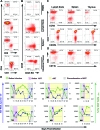Suppression of human immunodeficiency virus type 1 (HIV-1) viremia with reverse transcriptase and integrase inhibitors, CD4+ T-cell recovery, and viral rebound upon interruption of therapy in a new model for HIV treatment in the humanized Rag2-/-{gamma}c-/- mouse
- PMID: 19494021
- PMCID: PMC2715775
- DOI: 10.1128/JVI.00580-09
Suppression of human immunodeficiency virus type 1 (HIV-1) viremia with reverse transcriptase and integrase inhibitors, CD4+ T-cell recovery, and viral rebound upon interruption of therapy in a new model for HIV treatment in the humanized Rag2-/-{gamma}c-/- mouse
Abstract
A small animal model that reproduces human immunodeficiency virus type 1 (HIV-1) pathogenesis may allow modeling of new therapeutic strategies in ways not approachable in mononuclear cell culture. We find that, as in humans, combination antiretroviral therapy (ART) in humanized (hu-) Rag2(-/-)gamma(c)(-/-) mice allows suppression of viremia below the limits of detection and recovery of CD4(+) cells, while interruption of ART results in viral rebound and renewed loss of CD4(+) T cells. Failure of ART in infected mice is associated with the appearance of drug resistance mutations. The hu-Rag2(-/-)gamma(c)(-/-) mouse may therefore facilitate testing of novel approaches to HIV replication and persistence.
Figures


Similar articles
-
Latent HIV-1 infection of resting CD4⁺ T cells in the humanized Rag2⁻/⁻ γc⁻/⁻ mouse.J Virol. 2012 Jan;86(1):114-20. doi: 10.1128/JVI.05590-11. Epub 2011 Oct 19. J Virol. 2012. PMID: 22013038 Free PMC article.
-
HIV-1 infection and CD4 T cell depletion in the humanized Rag2-/-gamma c-/- (RAG-hu) mouse model.Retrovirology. 2006 Nov 1;3:76. doi: 10.1186/1742-4690-3-76. Retrovirology. 2006. PMID: 17078891 Free PMC article.
-
Establishment of a Novel Humanized Mouse Model To Investigate In Vivo Activation and Depletion of Patient-Derived HIV Latent Reservoirs.J Virol. 2019 Mar 5;93(6):e02051-18. doi: 10.1128/JVI.02051-18. Print 2019 Mar 15. J Virol. 2019. PMID: 30626677 Free PMC article.
-
HIV reservoirs: pathogenesis and obstacles to viral eradication and cure.AIDS. 2012 Jun 19;26(10):1261-8. doi: 10.1097/QAD.0b013e328353f3f1. AIDS. 2012. PMID: 22472858 Review.
-
Harnessing CD8+ T Cells Under HIV Antiretroviral Therapy.Front Immunol. 2019 Feb 26;10:291. doi: 10.3389/fimmu.2019.00291. eCollection 2019. Front Immunol. 2019. PMID: 30863403 Free PMC article. Review.
Cited by
-
A topical microbicide gel formulation of CCR5 antagonist maraviroc prevents HIV-1 vaginal transmission in humanized RAG-hu mice.PLoS One. 2011;6(6):e20209. doi: 10.1371/journal.pone.0020209. Epub 2011 Jun 1. PLoS One. 2011. PMID: 21673796 Free PMC article.
-
The utility of the new generation of humanized mice to study HIV-1 infection: transmission, prevention, pathogenesis, and treatment.Retrovirology. 2011 Aug 11;8:65. doi: 10.1186/1742-4690-8-65. Retrovirology. 2011. PMID: 21835012 Free PMC article. Review.
-
New generation humanized mice for virus research: comparative aspects and future prospects.Virology. 2013 Jan 5;435(1):14-28. doi: 10.1016/j.virol.2012.10.007. Virology. 2013. PMID: 23217612 Free PMC article. Review.
-
Studies of retroviral infection in humanized mice.Virology. 2015 May;479-480:297-309. doi: 10.1016/j.virol.2015.01.017. Epub 2015 Feb 11. Virology. 2015. PMID: 25680625 Free PMC article. Review.
-
The Contributions of Clinical Pharmacology to HIV Cure Research.Clin Pharmacol Ther. 2021 Aug;110(2):334-345. doi: 10.1002/cpt.2237. Epub 2021 Apr 18. Clin Pharmacol Ther. 2021. PMID: 33763860 Free PMC article. Review.
References
-
- Ambrose, Z., V. Boltz, S. Palmer, J. M. Coffin, S. H. Hughes, and V. N. KewalRamani. 2004. In vitro characterization of a simian immunodeficiency virus-human immunodeficiency virus (HIV) chimera expressing HIV type 1 reverse transcriptase to study antiviral resistance in pigtail macaques. J. Virol. 7813553-13561. - PMC - PubMed
-
- Ambrose, Z., S. Palmer, V. F. Boltz, M. Kearney, K. Larsen, P. Polacino, L. Flanary, K. Oswald, M. Piatak, Jr., J. Smedley, W. Shao, N. Bischofberger, F. Maldarelli, J. T. Kimata, J. W. Mellors, S. L. Hu, J. M. Coffin, J. D. Lifson, and V. N. KewalRamani. 2007. Suppression of viremia and evolution of human immunodeficiency virus type 1 drug resistance in a macaque model for antiretroviral therapy. J. Virol. 8112145-12155. - PMC - PubMed
-
- Baenziger, S., R. Tussiwand, E. Schlaepfer, L. Mazzucchelli, M. Heikenwalder, M. O. Kurrer, S. Behnke, J. Frey, A Oxenius, H Joller, A Aguzzi, M. G. Manz, and R. F. Speck. 2006. Disseminated and sustained HIV infection in CD34+ cord blood cell-transplanted Rag2−/−γc−/− mice. Proc. Natl. Acad. Sci. USA 10315951-15956. - PMC - PubMed
Publication types
MeSH terms
Substances
Grants and funding
- R37 AI44667/AI/NIAID NIH HHS/United States
- R21 AI081613/AI/NIAID NIH HHS/United States
- T32 AI007419/AI/NIAID NIH HHS/United States
- R21 AI081613-01A1/AI/NIAID NIH HHS/United States
- R37 AI044667/AI/NIAID NIH HHS/United States
- R01 AI080432/AI/NIAID NIH HHS/United States
- T32 GM007092/GM/NIGMS NIH HHS/United States
- R01 AI077454/AI/NIAID NIH HHS/United States
- T32 GM07092/GM/NIGMS NIH HHS/United States
- P30 AI050410/AI/NIAID NIH HHS/United States
- T32 AI07419/AI/NIAID NIH HHS/United States
- P30 AI50410/AI/NIAID NIH HHS/United States
LinkOut - more resources
Full Text Sources
Other Literature Sources
Medical
Research Materials

